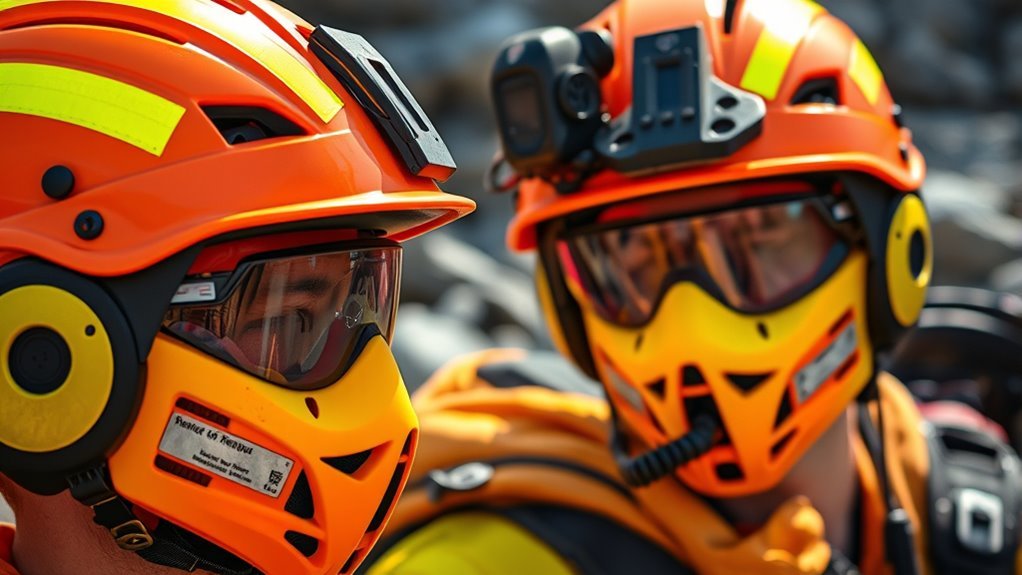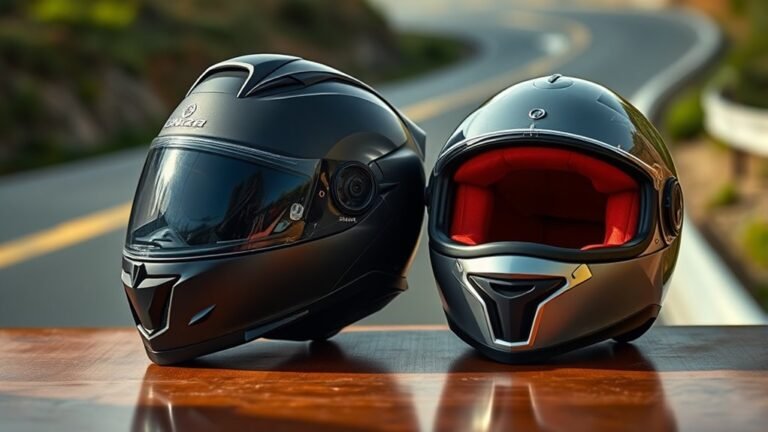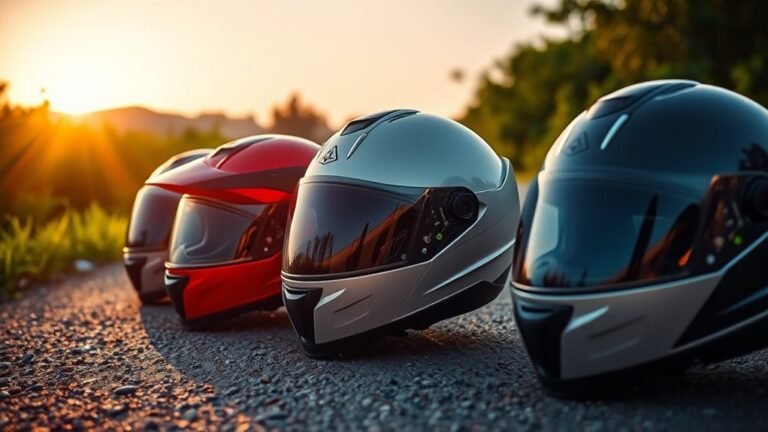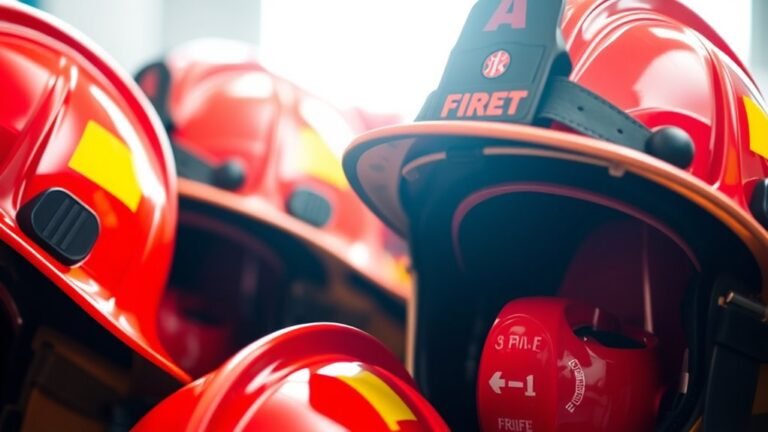Specialized Helmets for Search and Rescue Teams
Specialized helmets for search and rescue teams are essential for protecting against head injuries while enhancing situational awareness. These helmets provide vital impact resistance, thermal protection, and visibility in chaotic environments. Integrated communication systems allow for clear, hands-free collaboration, making real-time updates easier. Lightweight designs secure mobility during operations, while safety standards guarantee reliability. Customization options cater to specific mission requirements. Continue exploring to understand the latest technological advances that enhance safety and effectiveness in rescue missions.
The Importance of Head Protection in Search and Rescue Operations
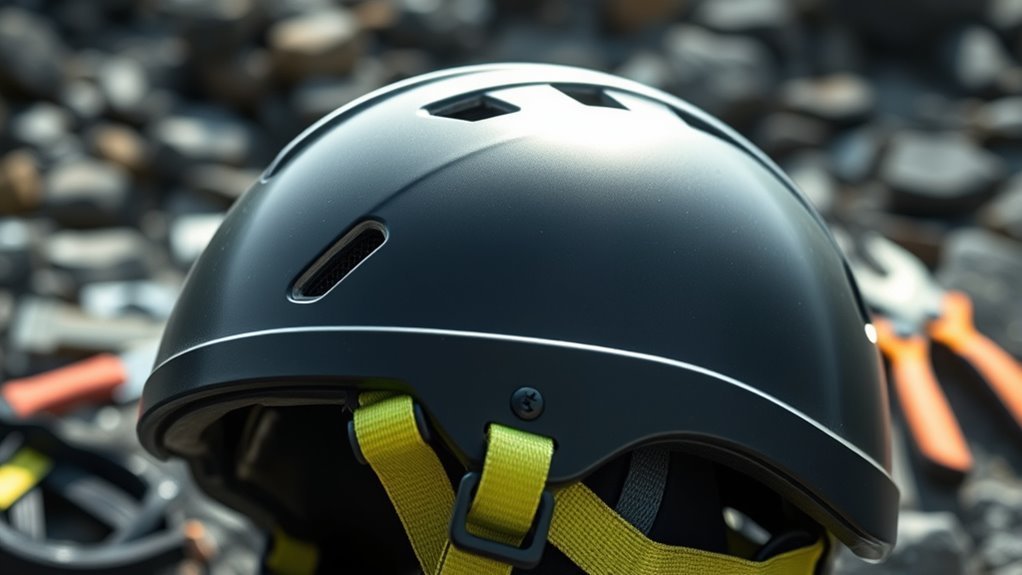
When you’re involved in search and rescue operations, the importance of head protection can’t be overstated. Head injuries are among the most common hazards faced by rescuers, often resulting from falling debris or unexpected impacts. Rescue statistics indicate that a significant percentage of injuries sustained during operations are head-related, emphasizing the critical need for effective headgear. Specialized helmets are designed to absorb impact and protect against sharp objects, ensuring your safety as you navigate challenging environments. Wearing a helmet not only safeguards your head but also enhances your situational awareness, allowing you to focus on the mission. By prioritizing head protection, you’re not just ensuring your own safety, but also enabling your team to operate effectively and confidently in high-risk scenarios.
Types of Specialized Helmets for Different Environments
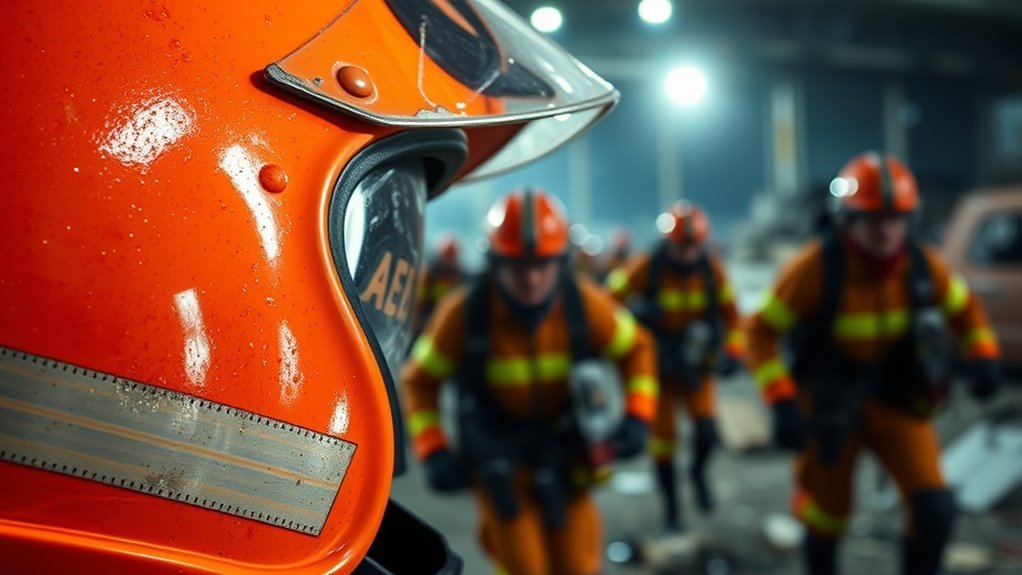
While operating in diverse environments, selecting the appropriate specialized helmet is essential for ensuring ideal protection. For mountain rescue, helmets should offer robust impact resistance and thermal protection against cold weather. In urban rescue scenarios, lightweight helmets with integrated communication systems enhance teamwork during tactical situations. Water rescue helmets are designed to float and feature drainage systems, ensuring safety in aquatic environments. For disaster response, versatile helmets provide compatibility with various accessories, such as headlamps or face shields. During aerial operations, helmets must incorporate secure straps and be aerodynamic. Cave rescue helmets require low-profile designs with headlamp attachments for confined spaces. Each helmet type is tailored to meet specific environmental challenges, ensuring you stay safe and effective in your mission.
Features of High-Visibility Helmets
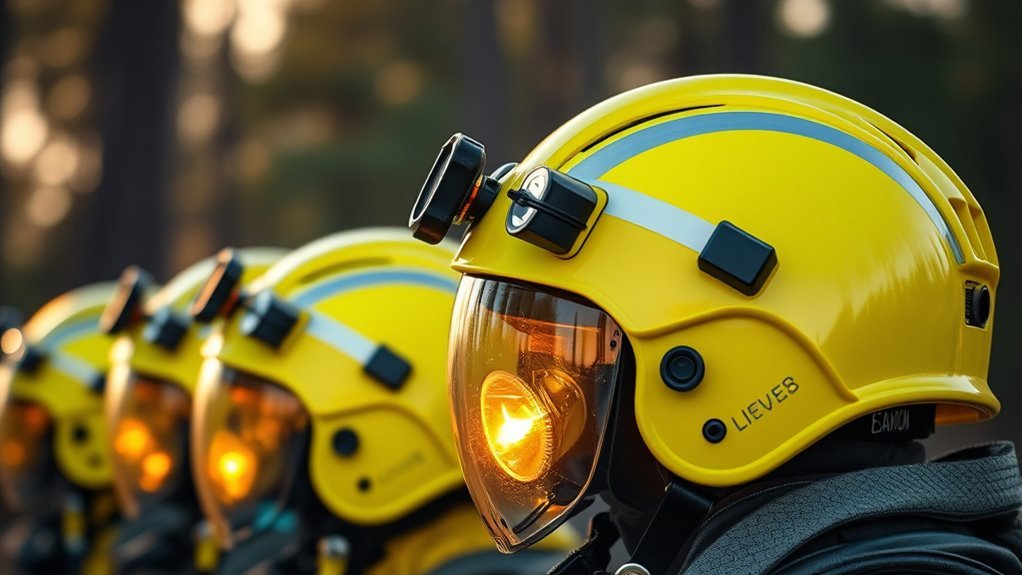
In various rescue scenarios, visibility can considerably impact safety and effectiveness, making high-visibility helmets an essential component of personal protective equipment. These helmets often feature bright colors and reflective elements to enhance visibility in low-light or chaotic environments.
Here are three critical aspects of high-visibility helmets:
- Durability Testing: They undergo rigorous durability testing to guarantee they can withstand harsh conditions.
- Color Options: Available in multiple color options, they allow teams to choose helmets that best fit their operational needs.
- Lightweight Design: A lightweight design guarantees comfort, allowing you to focus on the task at hand without the burden of heavy gear.
Choosing the right helmet can make a life-saving difference in critical situations.
Communication Systems Integrated Into Rescue Helmets
Effective communication is essential during rescue operations, especially in high-stress environments where every second counts. Modern rescue helmets now feature advanced communication systems that enhance communication clarity among team members. These integrated systems often include two-way radios, noise-canceling microphones, and earpieces designed to minimize interference from environmental sounds. Helmet integration allows you to maintain hands-free communication, ensuring that your focus remains on the task at hand. With intuitive controls built into the helmet, you can quickly adjust volume levels or switch channels without distraction. By using these innovative communication technologies, you’ll improve coordination, streamline operations, and ultimately save more lives. Investing in helmets with integrated communication systems is a game-changer for any search and rescue team.
Impact Resistance and Safety Standards
As rescue operations often expose team members to unpredictable hazards, the importance of impact resistance and adherence to safety standards in helmets cannot be overstated. These specialized helmets undergo rigorous impact testing to guarantee they meet safety certifications, providing you with the protection you need in critical situations.
Consider these crucial aspects:
Consider these essential factors for helmet safety: durability, compliance with standards, and the peace of mind they provide.
- Durability: Helmets must withstand significant force, preventing head injuries.
- Compliance: Meeting established safety standards guarantees reliability in life-threatening scenarios.
- Peace of Mind: Knowing your gear is tested and certified allows you to focus on saving lives, not worrying about your safety.
Investing in helmets that prioritize impact resistance can be the difference between life and death. Your freedom to act decisively depends on it.
Heat and Flame Resistance in Specialized Helmets
Heat and flame resistance is a crucial feature in specialized helmets for search and rescue teams, as these professionals often operate in environments where exposure to extreme temperatures and fire hazards is a real threat. Helmets designed with thermal insulation and flame retardant materials guarantee safety, allowing you to focus on the mission at hand without worrying about heat-related injuries.
| Feature | Description | Importance |
|---|---|---|
| Thermal Insulation | Reduces heat transfer, protecting your head | Prevents overheating during operations |
| Flame Retardant | Resists ignition and combustion | Enhances safety in fire-prone areas |
| Durability | Withstands harsh conditions | Guarantees long-term reliability |
These attributes are essential for maintaining your safety during critical rescue operations.
Lightweight Designs for Enhanced Mobility
While traversing challenging environments, lightweight designs in specialized helmets are essential for enhancing mobility during search and rescue operations. These helmets, crafted with ergonomic designs, guarantee you can move freely and efficiently, allowing you to focus on the mission at hand.
Consider the following mobility enhancements:
- Reduced Weight: Lighter materials decrease fatigue, letting you perform longer without strain.
- Improved Fit: Ergonomic designs contour to your head shape, minimizing shifting and distractions.
- Streamlined Features: Integrated gear and accessories enhance functionality without adding bulk.
These aspects not only promote agility but also empower you to navigate complex terrains with confidence. With the right helmet, you can embrace the freedom to act swiftly and decisively, essential for successful rescue operations.
Customization Options for Specific Rescue Needs
In search and rescue operations, helmets must not only be lightweight but also adaptable to various scenarios. Custom fit is essential, ensuring your helmet conforms comfortably to your head, allowing for long hours of wear without discomfort. Many helmets offer modular accessories that can be added or removed based on the mission’s requirements. For example, you might need a face shield for hazardous environments or a communication system for team coordination. These options empower you to tailor your helmet perfectly for each unique rescue operation. Additionally, interchangeable visors and lighting attachments can enhance visibility in low-light situations. By utilizing these customization options, you can optimize your helmet’s functionality, ensuring you’re prepared for any challenge that comes your way.
The Role of Helmets in Team Coordination and Efficiency
Effective team coordination during search and rescue operations hinges greatly on the use of specialized helmets. These helmets enhance team dynamics and boost operational efficiency, guaranteeing every member remains connected and informed. Here’s how they contribute:
Specialized helmets are crucial for effective team coordination in search and rescue, enhancing communication and ensuring safety and visibility.
- Communication: Integrated communication systems allow for real-time updates, minimizing errors and enhancing responsiveness.
- Safety: Protective features guarantee that team members can focus on their tasks without fear, fostering a sense of freedom to act decisively.
- Visibility: Bright colors and reflective surfaces improve visibility, allowing team members to easily locate each other in chaotic environments.
Advances in Technology for Search and Rescue Helmets
As technology evolves, search and rescue helmets are becoming increasingly sophisticated, integrating features that enhance performance and safety. Modern helmets now utilize smart materials, allowing for lightweight yet durable designs that adapt to various environmental conditions. These materials can absorb impacts and provide thermal regulation, ensuring comfort and protection during intense operations. Additionally, helmet sensors have revolutionized the way teams operate, offering real-time data on environmental hazards and user health indicators. These sensors can monitor heart rates, detect falls, and even provide GPS tracking, enhancing situational awareness. By incorporating these advanced technologies, search and rescue teams are better equipped to respond effectively, ensuring both team safety and operational efficiency in critical situations.
Frequently Asked Questions
What Is the Average Lifespan of a Rescue Helmet?
The average lifespan of a rescue helmet is typically around 5 to 10 years, depending on helmet durability factors like exposure to UV light, chemicals, and physical wear. You should follow replacement guidelines provided by the manufacturer, as they often recommend retiring a helmet after significant impacts or after a specified time frame. Regular inspections can help guarantee your helmet remains effective, keeping you safe during critical operations while maintaining your freedom to act decisively.
How Do I Properly Maintain My Rescue Helmet?
To keep your rescue helmet in peak condition, think of it as a knight’s armor! Regular helmet inspections are essential; check for cracks or dents after each use. Clean it with mild soap and warm water, avoiding harsh chemicals that could damage the materials. Rinse thoroughly and air dry. Always make certain the straps are secure and functional. Following these helmet inspection tips and cleaning methods will guarantee your gear’s longevity and reliability.
Are There Helmet Options for Those With Larger Heads?
Yes, there are helmet options for those with larger heads. Many manufacturers offer custom sizing to guarantee a proper fit. You can also look for models with adjustable features, such as removable padding or adjustable straps, which allow you to tailor the helmet’s fit more precisely. When considering a helmet, check the specifications for maximum size and comfort to ascertain it meets your needs while providing ideal safety during your activities.
Can Helmets Be Fitted With Personal Protective Equipment?
Yes, helmets can definitely be fitted with personal protective equipment. Think of it like adding a Swiss Army knife to your gear—versatile and functional. You can use helmet accessories such as visors, communication devices, or even lights to enhance safety. Additionally, integrating protective gear like face shields or earmuffs guarantees thorough protection during operations. It’s essential to confirm compatibility with your helmet model for peak performance and comfort while maintaining your freedom of movement.
What Color Options Are Available for Specialized Helmets?
Specialized helmets come in various color options, including high-visibility shades like bright yellow, orange, and lime green. These colors are essential for enhancing visibility factors in emergency situations, ensuring that team members can easily spot each other. Additionally, colors like red or blue may signify specific roles or functions within the team, adding to the color significance. You can choose the options that best fit your operational needs while prioritizing safety and visibility.
